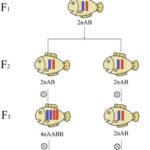
Fish farmers and researchers have long been seeking innovative techniques to improve fish breeding and understand evolutionary processes. Two powerful tools emerging in this field are distant hybridization and gynogenesis.
A study published in the journal Reviews in Aquaculture by researchers from Hunan Normal University delves into these fascinating methods, exploring how they manipulate fish genetics and contribute to the diversification of our finned friends.
Diversifying the Gene Pool: Distant Hybridization
- 1 Diversifying the Gene Pool: Distant Hybridization
- 2 Gynogenesis: A Mother’s Legacy
- 3 The Intersection of Distant Hybridization and Gynogenesis
- 4 Macro vs. Micro: Decoding the Hybrid Landscape
- 5 Shaping the Future of Fish: Applications and Potential
- 6 The Road Ahead: Exploring New Frontiers
- 7 Entradas relacionadas:
Imagine crossing fish from entirely different species! Distant hybridization makes this possible. By breeding fish with more distantly related evolutionary lineages, scientists can create offspring, or hybrids, with unique combinations of genes. These hybrids, known as macrohybrids, possess two distinct sets of chromosomes—one from each parent—resulting in fascinating possibilities. Some macrohybrids, such as allodiploids and allotetraploids, have one or two sets of chromosomes from each parent, respectively.
However, significant genetic differences can hinder successful reproduction, leading to problems with mating, fertilization, embryonic development, and larval survival. Nevertheless, researchers have developed techniques to overcome these barriers, such as artificial fertilization and hormone treatments.
Gynogenesis: A Mother’s Legacy
Gynogenesis takes a different approach. This technique enables the creation of offspring solely from the female’s genetic material. Essentially, the sperm from a male of a different species (or even no sperm at all) triggers the development of the egg without fertilization. The resulting offspring, often called microhybrids, inherit almost all their DNA from the mother, but in some cases, small fragments of paternal DNA can be incorporated. This includes autodiploids and autotetraploids (offspring with duplicated or quadrupled sets of chromosomes from the mother), as well as those produced through artificial gynogenesis.
The Intersection of Distant Hybridization and Gynogenesis
While distant hybridization and gynogenesis may seem unrelated, intriguing connections exist between them. In the process of distant hybridization, natural gynogenetic offspring can sometimes appear, even without intentional sperm inactivation or egg shock treatments. These offspring may exhibit both maternal and paternal traits, suggesting the influence of paternal DNA.
This phenomenon raises fascinating questions about the potential for new species to arise through natural processes similar to distant hybridization. It’s a topic of great interest in evolutionary biology.
Macro vs. Micro: Decoding the Hybrid Landscape
Researchers have proposed two categories to classify fish born through these techniques:
Stay Always Informed
Join our communities to instantly receive the most important news, reports, and analysis from the aquaculture industry.
- Macrohybrids: These offspring inherit distinct “sub-genomes” from both parents. Examples include allodiploid and allotetraploid lineages.
- Microhybrids: These fish primarily inherit their genome from the mother, with only small contributions of paternal DNA. This category includes autodiploid and autotetraploid lineages, as well as those produced through artificial gynogenesis.
Shaping the Future of Fish: Applications and Potential
Both distant hybridization and gynogenesis offer exciting possibilities for fish breeding and research. These techniques can:
- Introduce desirable traits: By combining genomes from different species, scientists can potentially create fish with improved growth rates, disease resistance, or other valuable characteristics.
- Unlock genetic variation: These methods generate offspring with unique genetic combinations, providing valuable resources for studying fish evolution and adaptation.
- Develop sterile fish: Triploid fish, created by manipulating chromosome numbers during hybridization, can be sterile, preventing unwanted reproduction in aquaculture settings.
The Road Ahead: Exploring New Frontiers
The future of distant hybridization and gynogenesis in fish is promising. Researchers are actively exploring ways to refine these techniques and unlock their full potential. This includes:
- Understanding underlying mechanisms: Delving into the biological processes that govern these techniques can help us optimize them for specific goals.
- Developing new applications: Expanding the use of these methods in fish breeding and conservation efforts holds great promise.
- Ensuring responsible use: Careful consideration of potential ecological impacts is crucial for the responsible application of these techniques.
By harnessing the power of distant hybridization and gynogenesis, we can usher in a new era of fish diversity, advancing aquaculture, research, and our understanding of evolution itself. Stay tuned to AquaHoy as we continue to explore these exciting frontiers in fish breeding science!
The study was funded by the National Natural Science Foundation of China, the Earmarked Fund for China Agriculture Research System, the Youth Science and Technology Talents Lifting Project of Hunan Province, and the 111 Project.
Contact
Shaojun Liu
State Laboratory of Developmental Biology of Freshwater Fish, Hunan Normal University
Changsha, China
Email: lsj@hunnu.edu.cn
Reference (open access)
Liu, Q., Wang, S., Tang, C., Tao, M., Zhang, C., Zhou, Y., Qin, Q., Luo, K., Wu, C., Hu, F., Wang, Y., Liu, Q., Li, W., Wang, J., Zhao, R., & Liu, S. The Research Advances in Distant Hybridization and Gynogenesis in Fish. Reviews in Aquaculture. https://doi.org/10.1111/raq.12972
Editor at the digital magazine AquaHoy. He holds a degree in Aquaculture Biology from the National University of Santa (UNS) and a Master’s degree in Science and Innovation Management from the Polytechnic University of Valencia, with postgraduate diplomas in Business Innovation and Innovation Management. He possesses extensive experience in the aquaculture and fisheries sector, having led the Fisheries Innovation Unit of the National Program for Innovation in Fisheries and Aquaculture (PNIPA). He has served as a senior consultant in technology watch, an innovation project formulator and advisor, and a lecturer at UNS. He is a member of the Peruvian College of Biologists and was recognized by the World Aquaculture Society (WAS) in 2016 for his contribution to aquaculture.




